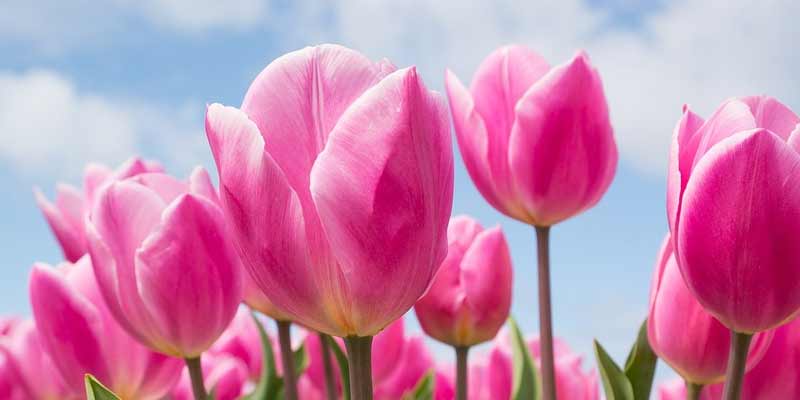Revered as spring’s harbingers, tulips enchant with their vibrant hues and captivating blossoms; they transform gardens into kaleidoscopes of color. To successfully cultivate these botanical gems, one must grasp the delicate balance involved in fulfilling their water requirements: a task that commands precision. Adequate watering, a practice critical for robust growth, vibrant blooms, and an alluring floral spectacle is thus achieved through this understanding.
This guide delves into the intricate balance of art and science involved in watering tulips. It explores factors that influence the frequency of watering, while also providing practical tips to fuel these beloved flowers towards their maximum potential.
Understanding Tulip Watering Needs
In the life cycle of tulips, water plays a vital role: it sustains their growth; supports their metabolism, and crucially facilitates flower development. As with all plants—striking an optimal watering balance is paramount: under-watering can result in stunted growth and inadequate blossoming; over-watering may induce bulb rot or fungal diseases.
Native to regions with well-drained soil and moderate rainfall, tulips exhibit a relative tolerance for dry conditions. Yet, during their active growth phases: regular moisture becomes advantageous; it supports root development – foliage expansion–and flower formation.
4 Factors Influencing Watering Frequency
The frequency and intensity of required watering for tulips are influenced by several factors; understanding these variables, a crucial comprehension in gardening empowers gardeners to customize their practices. They can thus meet the specific needs of their tulip plants, they must consider key factors such as:
1. Soil
Tulips flourish in soil that drains well, allowing excess water to percolate freely. This prevents both waterlogging and root suffocation, which is a factor crucial for healthy tulip growth. Sandy or loamy soils — possessing good drainage — encourage effective movement of air and water around. the root zone; this promotes robust root development while simultaneously reducing risks associated with excessive moisture– a win-win situation indeed!
2. Weather Patterns
Such as rainfall, temp.erasure, humidity, and wind. These factors significantly determine the watering needs of tulips. Tulip plants may require more frequent watering during hot and particularly dry periods to compensate for moisture loss via both evaporation and transpiration.
On the other hand, excessive rainfall or prolonged periods of wet weather might oversaturate the soil; this intensifies the peril of root rot and fungal infections.
3. Growth Stage
Tulips exhibit clear stages of growth, dormancy, emergence, vegetative development, flowering, and then another phase of dormancy. Aligning watering practices with these specific periods ensures optimal moisture levels for the tulips; this support is vital in meeting their physiological requirements.
During the early stages of growth and establishment, newly planted tulip bulbs necessitate consistent moisture. This allows them to initiate root development; further – it aids in their acclimation to the surrounding environment.
4. Container Planting vs. Ground Planting
The watering needs of container-grown tulips diverge from those directly planted in soil. Container-grown tulips, with their limited access to soil moisture, may dehydrate rapidly, particularly in warm and windy conditions. Keep a close watch on these container-based specimens; only supply water as necessary: the goal is to maintain consistent soil moisture levels without saturating the roots.
Guidelines for Watering Tulips
To achieve the ideal balance in watering tulips, one must blend observation, intuition, and adherence to best practices. Herein lie some guidelines—crucial signposts for your navigation toward effective tulip watering:
Regularly monitor the soil moisture of your tulip plants by inserting your finger into the soil to a depth of approximately 2 inches (5 cm); if you feel that it’s dry, take action by watering the plant. If, on the contrary, the soil exudes a sense of moisture or waterlogging; it is prudent to abstain from watering, allowing for a slight drying-out period.
Watering Frequency
Aim to deep-water tulips infrequently, ensuring the soil dries out between each session. Deep watering fosters resilience and encourages robust root growth; conversely, frequent shallow irrigation can encourage vulnerable shallow root systems that are sensitive to moisture changes.
Time of Day
Early morning constitutes the optimal time for watering tulips; this strategy minimizes water loss through evaporation and importantly ensures that foliage receives ample time to dry before nightfall. It is imperative to avoid late afternoon or evening waterings since prolonged moisture on leaves significantly heightens the risk of fungal diseases.
Watering Technique
Utilize a gentle watering method, for instance, a soaker hose or drip irrigation system; these options allow you to deliver water directly to the root zone while minimizing wastage.
Refrain from employing overhead techniques of water delivery as they have two potential drawbacks: first, it may dampen the foliage—a condition that can heighten tulips’ vulnerability to foliar diseases—and secondly; this approach is less efficient leading to increased water loss through evaporation.
Apply Mulch
Apply a layer of organic mulch – shredded bark or compost, for instance – around the base of tulip plants: this action serves three crucial purposes.
Firstly, it conserves soil moisture; secondly, suppresses weed growth; and finally maintains a more consistent soil temperature. Furthermore—promoting overall soil health and reducing water loss through evaporation are additional benefits that mulching provides.
Seasonal Adjustments
To accommodate shifts in weather patterns and growing conditions, seasonally modify your watering schedule. Enhance the frequency of watering during hot, dry periods; conversely, decrease it when faced with cooler and wetter seasons – this will ward off issues like waterlogged soil or root rot.
Conclusion
Both an art and a science, the task of watering tulips demands careful observation; thoughtful consideration, and a deep understanding even, of the plant’s water needs. Gardeners can foster healthy, resilient tulip plants that dazzle with their vibrant blooms and captivating beauty by monitoring soil moisture: adapting to changing weather conditions; and employing best watering practices. Embrace nature’s rhythm then nurture your tulips meticulously and revel in splendor when her jewels adorn your garden.



Leave a Reply